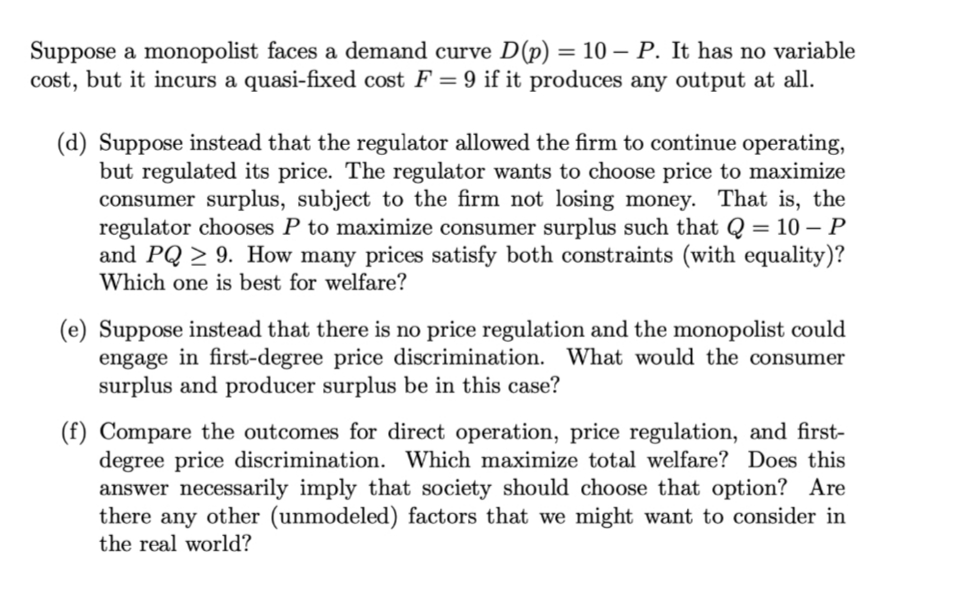Suppose a monopolist faces a demand curve D(p) = 10 - P. It has no variable cost, but it incurs a quasi-fixed cost F = 9 if it produces any output at all. (d) Suppose instead that the regulator allowed the firm to continue operating, but regulated its price. The regulator wants to choose price to maximize consumer surplus, subject to the firm not losing money. That is, the regulator chooses P to maximize consumer surplus such that Q = 10 - P and PQ ≥ 9. How many prices satisfy both constraints (with equality)? un
Suppose a monopolist faces a demand curve D(p) = 10 - P. It has no variable cost, but it incurs a quasi-fixed cost F = 9 if it produces any output at all. (d) Suppose instead that the regulator allowed the firm to continue operating, but regulated its price. The regulator wants to choose price to maximize consumer surplus, subject to the firm not losing money. That is, the regulator chooses P to maximize consumer surplus such that Q = 10 - P and PQ ≥ 9. How many prices satisfy both constraints (with equality)? un
Chapter14: Monopoly
Section: Chapter Questions
Problem 14.9P
Related questions
Question
2

Transcribed Image Text:Suppose a monopolist faces a demand curve D(p) = 10 - P. It has no variable
cost, but it incurs a quasi-fixed cost F = 9 if it produces any output at all.
(d) Suppose instead that the regulator allowed the firm to continue operating,
but regulated its price. The regulator wants to choose price to maximize
consumer surplus, subject to the firm not losing money. That is, the
regulator chooses P to maximize consumer surplus such that Q = 10- P
and PQ ≥ 9. How many prices satisfy both constraints (with equality)?
Which one is best for welfare?
(e) Suppose instead that there is no price regulation and the monopolist could
engage in first-degree price discrimination. What would the consumer
surplus and producer surplus be in this case?
(f) Compare the outcomes for direct operation, price regulation, and first-
degree price discrimination. Which maximize total welfare? Does this
answer necessarily imply that society should choose that option? Are
there any other (unmodeled) factors that we might want to consider in
the real world?
Expert Solution
This question has been solved!
Explore an expertly crafted, step-by-step solution for a thorough understanding of key concepts.
Step by step
Solved in 2 steps

Knowledge Booster
Learn more about
Need a deep-dive on the concept behind this application? Look no further. Learn more about this topic, economics and related others by exploring similar questions and additional content below.Recommended textbooks for you


Managerial Economics: Applications, Strategies an…
Economics
ISBN:
9781305506381
Author:
James R. McGuigan, R. Charles Moyer, Frederick H.deB. Harris
Publisher:
Cengage Learning



Managerial Economics: Applications, Strategies an…
Economics
ISBN:
9781305506381
Author:
James R. McGuigan, R. Charles Moyer, Frederick H.deB. Harris
Publisher:
Cengage Learning



